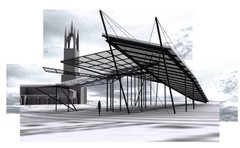This is called "Architectural Light and Magic" as under these headings multimedia content (typically video) relating to my project will be posted. This Beta entry is a test link for integrating video into my blog so that I can use the code as reference for when I create additional entries. Its by Leonardo Robanni (http://www.youtube.com/profile?user=leonardobonanni) and is a "finalist competition entry for the kendall square interactive competition" which I randomly found and thought would be a good test link to try out.
What this means is that I can add video of my work onto this site too... cool!
